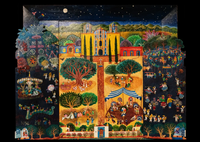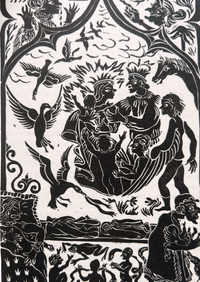“For most of human history, 'literature', both fiction and poetry, has been narrated, not written - heard, not read. So fairy tales are a vital connection we have with the imaginations of ordinary men and women."
My children are not large-appetite readers. This wrings my heart occasionally, for I have always filled the iced fissures of life with the melting warmth of books—their knowledge, insight, newness, depth, and imaginative mirror of self. But my quick parental disappointment notwithstanding, my children's absent bibliomania is not too consequential because reading and storytelling are not the same thing. Their non-reading does not mean they are not literate; they merely dislike silence. As Angela Carter (May 7, 1940 – February 16, 1992) reminds us in the opening of her groundbreaking collection of fairy tales with female heroines, "speaking is public activity and reading is private activity."
For most of human history, 'literature', both fiction and poetry, has been narrated, not written - heard, not read. So fairy tales, folk tales, stories from the oral tradition, are all of them the most vital connection we have with the imaginations of ordinary men and women.
In the early 1990s, up until a month before she died, Carter assembled two collections of oral tradition - that is, fairy tales passed down/up to modern day. You may find both collections together in Angela Carter's Book of Fairy Tales. It is a generous helping of women - fit and flawed - being women.
Although this is called a book of fairy tales, you will find very few actual fairies within the following pages. Talking beasts, yes; beings that are, to a greater or lesser extent, supernatural; and many sequences of events that bend the laws of physics. But fairies, as such, are thin on the ground, for the term 'fairy tale' is a figure of speech, and we use it loosely to describe the great mass of infinitely various narrative that was, once upon a time and still is, sometimes, passed on and disseminated through the world by word of mouth - stories without known originators that can be remade again and again by every person who tells them, the perennially refreshed entertainment of the poor.
 Carter's Book of Fairy Tales was illustrated using woodcuts done by her lifelong friend and collaborator, Corinna Sargood. Sargood's "Santa Ana" diorama. Learn more. Photograph by Dan Hopkins.
Carter's Book of Fairy Tales was illustrated using woodcuts done by her lifelong friend and collaborator, Corinna Sargood. Sargood's "Santa Ana" diorama. Learn more. Photograph by Dan Hopkins.My daughters allow a slim sliver of silence, only when eating and never for long. Given this prolixity, reading works poorly. But oral storytelling works brilliantly. For example, pigeons recently took roost near our backdoor. They do not do much, these pigeons, not much at all. Occasional sentry obligations, some huffing and puffing to announce their ongoing presence. (So much animal time is spent announcing: "I'm here! I'm here! I'm here!" to no one in particular.) - But what a world we've created for these pigeons! What drama befalls them. My eldest named them Ellen Roseberry and Felix and their (to be hatched) daughter Ellix, I provide drama. My youngest bounds our narrative and her developing self by noting when something is too scary (Child: "Mummy that's too scary!' Me: 'Should I continue?' Child 'Yes!')
I suppose the genre is modern realism, neither magic nor unique, we give them a verisimilitude of Winnie the Pooh (C. S. Lewis spent his childhood in such concocted worlds). We suspend reality to believe animals behave like humans but not enough to believe they have powers. (Although Felix did fart a rainbow Thursday last).
Are these fairy tales? They could develop into such. They are oral, imaginative, cobbled together next to beds and fires and spoken aloud, gracefully, clumsily, with aspiration and human voice. Being read to is indeed comforting and wondrous, but being told a story, is a unique human art.
Carter redefines the genre:
Until the middle of the nineteenth century, most poor Europeans were illiterate or semi-literate, and most Europeans were poor. Parts of Africa, Latin America, and Asia remains poorer than ever, and there are still languages that do not yet exist in any written form or, like Somali, have acquired a written form only in the immediate past. Yet Somali possesses literature no less glorious for having existed in the memory, and the mouth for the greater part of its history, and its translation into written forms will inevitably change the whole nature of that literature because speaking is a public activity and reading is private activity. For most of human history, 'literature', both fiction and poetry, has been narrated, not written - heard, not read. So fairy tales, folk tales, and stories from the oral tradition are all the most vital connection we have with the imaginations of the ordinary men and women whose labour created our world.
 Woodcut print by Corinna Sargood.
Woodcut print by Corinna Sargood.The development of these tales, therefore, is oriented around the space in which they are created, the home. The grand tradition of domestic arts and crafts calls on things we see in and around the house. How many fairy tales include some sort of cottage, hearth, family unit, or bed? Or, in our case, a bird's nest. Carter even tells us to "think in terms of domestic arts."
The history, sociology and psychology transmitted to us by fairy tales are unofficial - they pay even less attention to national and international affairs than Jane Austen's novels. They are also anonymous and genderless. We may know the name and gender of the particular individual who tells a particular story just because the collector noted the name down, but we can never know the name of the person who invented that story in the first place. ... But fairy tales are not like that, nor are their makers. Who first invented meatballs? In what country? Is there a definitive recipe for potato soup? Think in terms of the domestic arts. 'This is how I make potato soup.'
In this way, we have a developing, living, and breathing literature. Carter's Fairy Tales is unique and powerful because they counter our small-mindedness when it comes to literature and female characters; Carter's tales feature women who are cunning, strong, clever, resourceful, bold, beautiful, and my favourite, 'up to something.' In short, women being women. The women are not demeaned for being women, not second-best, not kept in castles or hidden. They are not people-pleasing, honest, or even good. Carter is emphatic that women are not all the same, and these stories do not celebrate that sameness; in fact, they celebrate the opposite.
Sisters under the skin we might be, but that doesn't mean we've got much in common. I wanted to demonstrate the extraordinary richness and diversity of responses to the same common predicament - being alive - and the richness and diversity with which femininity, in practice, is represented in "unofficial" culture: its strategies, its plots, its hard work.
Carter died in 1992 while finishing the second half of her collection (she wrote while in hospital), and something about the book form falls short of its tradition. I'm trying to commit a few to memory so I can tell them to the girls rather than read them. Carter's collection is, much like Jorge Luis Borges's multiple editions of fantastical creatures minus the narrative - something that is never done, only paused. - For more on this precise selection of fairy tales, collected and refashioned by Carter, who instinctively avoids nominal divisions like time or geography and instead collates the tales under categories like "Strong Minds and Low Cunning," "Sillies," and "Unhappy Families" look here.


 Corinna Sargood's "The Creation" tapestry.
Corinna Sargood's "The Creation" tapestry.